... $2 billion for projects enhancing trade. Nominated projects will be picked for funding by the California Transportation Commission in April.
In a few cases, work is steaming ahead. Double-stacked containerized rail freight from Virginia’s Hampton Roads ports will, after 2010, travel a more direct route to the Midwest thanks to a $309-million public-private partnership.
| + click to enlarge |
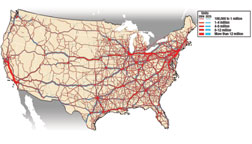 I-95 Coalition |
The Heartland Corridor collaboration between U.S. DOT, Virginia, West Virginia, Ohio and Norfolk Southern Railroad will enlarge tunnels and remove overhead obstructions along a 670-mile route between Portsmouth, Va., and Columbus, Ohio, eliminating detours of up to 200 miles.
The Heartland Corridor marks the first time that a private railroad and the federal government have teamed up to develop and finance a rail improvement program. Norfolk Southern, investing about $81.4 million in Heartland Corridor projects, brought the proposal to DOT in 2001. Results of feasibility studies led to the allocation of $140 million in federal funds, plus funds from state agencies.
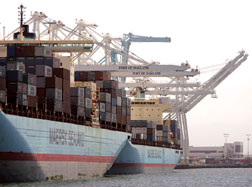 AP/Wideworld PPPs could fund Port of Oakland work
|
“Norfolk Southern would not be able to justify a capital project of this magnitude on its own,” says NS spokesperson Robin Chapman. “A partnership in which the railroad and the public entities each contribute in proportion to the benefits they receive—expanded capacity in a crucial corridor, economic development opportunities and reduced highway congestion—makes it possible.”
The three-year, $151-million centerpiece focuses on raising the vertical clearances of 29 tunnels totaling more than 30,000 ft in the mountains of Virginia, West Virginia and Kentucky to a minimum of 20 ft., 9 in. Options include realigning tracks, lowering track beds, notching corners into arched ceilings and excavating and replacing liners. The overburden of one 174-ft tunnel in West Virginia may be removed.
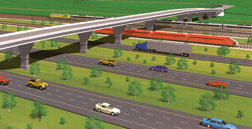
Texas DOT Texas plans Trans-Texas Corridor
|
“We looked for cost-effective opportunities to minimize or avoid having to make structural modifications wherever possible,” says Frank Frandina, executive vice president for Hatch Mott McDonald (HMM), Milburn, N.J., Norfolk Southern’s design engineer. HMM principal project manager Richard Buck notes that a lack of as-built data on older tunnels challenged the investigation and design phases. “What we saw was what we had,” Buck says.
Tunnel features such as clearance and concrete thickness can be easily verified, but pervasive random seams of loose material can escape detection by even the most meticulous geotechnical probing. “We’re always uncertain of those conditions until we start demolition and see what’s actually there,” says Jim Carter, NS chief engineer for bridges and structures. “That’s when we’ll see if the borings are correct.”
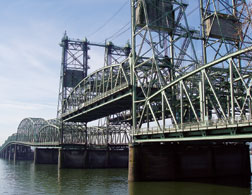
Oregon DOT I-5 corridor improvement plan in Oregon
|
The first year-long project, replacing the liner on the 3,302-ft Cowan Tunnel in southwest Virginia, began in October. Modifications to four tunnels near Roderfield, W.Va., began this month. Another four-tunnel contract is being finalized. Other contracts will be awarded in phase. Projects include constructing three intermodal terminals and modifying the upper bracing of eight railroad truss bridges.
Despite concerns over the availability of qualified contractors, “we have had some encouraging interest in future contracts that lead us to remain optimistic about meeting our schedule at this point,” Carter says.
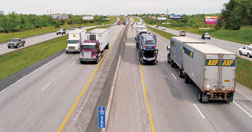 Missouri DOT I-70 truck-only lanes in the MIdwest are in feasibility phases
|
FHWA’s Eastern Federal Lands Highway Division was chosen as the federal partner in part for its ability to foster collaboration, says FHWA spokesperson Ron Zeitz. While Zeitz says it is too early to fully assess the success of using the PPP approach for other freight corridor projects, the initial results are promising. “I can see it being encouraged in the future,” he says. “Railroads have historically been reluctant to work with the federal government, which results in them missing opportunities to team up on capacity improvements. The Heartland Corridor may well help change that mindset.”
Developing Scene
Other projects partly funded by Corridors of the Future are in gestation. “When we look at the challenge of growing freight numbers, we have to think multimodal,” says Scott Varner, deputy director for Ohio DOT. Ohio has an initiative with Indiana, Illinois and...

Post a comment to this article
Report Abusive Comment